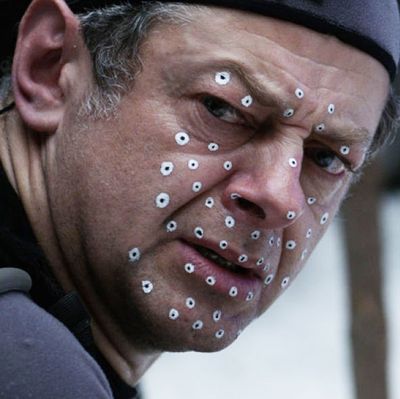
For a guy who has remained one of Hollywood’s consistently employed actors, appearing in the biggest of big-budget movies for the last two decades and playing key roles in such blockbusters as the Lord of the Rings trilogy, the Planet of the Apes films, and The Adventures of Tintin, Andy Serkis has managed to retain an unusual level of anonymity. Many fans probably wouldn’t be able to pick him out of a police lineup, because Serkis’s motion-capture performances of characters such as Godzilla and Supreme Leader Snoke in Star Wars: The Force Awakens arrive onscreen cloaked in layers upon layers of computer-generated imagery.
The monsters maestro makes his mo-cap directorial debut with Mowgli: Legend of the Jungle, which arrived in limited theatrical release on November 29 and began streaming on Netflix on December 7. Based on Rudyard Kipling’s Mowgli stories (also the basis for Disney’s 2016 hit live-action version of The Jungle Book), the fantasy-drama features mo-cap performances from an A-list cast that includes Christian Bale, Cate Blanchett, Naomie Harris, and Benedict Cumberbatch, as well as Serkis himself, all portraying jungle animals. But viewed a certain way, Mowgli stands as the capstone to a career in which Serkis has remained the foremost pioneer of both performance-capture and motion-capture technology: often misunderstood and largely anonymous forms of 3-D animation that the actor-director likens to “digital makeup” (to the vocal chagrin of effects technicians) that have revolutionized filmmaking and are helping redirect the way actors — such as Oscar winners Mark Rylance in The BFG and Tom Hanks in The Polar Express — ply their trade by making the possibility of total physical transformation something real.
In a posh suite at a Beverly Hills hotel, Serkis broke down his five most groundbreaking mo-cap movie performances, and walked Vulture through various great leaps forward in motion-capture technology over the past 18 years. But the actor-director (who Rolling Stone memorably called the “King of Post-Human Acting”) also took pains to clear up the chief misconception about his metier. “I think there is a big realization that there is nothing to be afraid of, that this is acting, that it is as valid a form of expression as any other form of performance,” Serkis says. “The messaging and understanding what performance capture is has been difficult to explain to the general public. I’ve always said that performance capture is not a type of acting — it’s just a different set of cameras filming an actor. You are literally driving a digital mask.”
Gollum in all three Lord of the Rings films as well as in Jackson’s 2012 spinoff The Hobbit: An Unexpected Journey
Back in 1999, before Peter Jackson’s The Lord of the Rings: The Fellowship of the Ring started production, motion capture was the exclusive province of video games: a glitchy, primitive form of animation largely untapped by Hollywood. The British-born Serkis, for his part, was a former stage actor resigned to spend his career performing in low-budget Ken Loach–style socio-realist dramas. But when it came to concocting the alternately sniveling and devious Hobbit character Gollum, Jackson’s decision to cast the actor would change both the course of his career and the face of modern moviemaking.
“The way he described it to me was, ‘We want an actor to play Gollum on set. The character is going to be manifested as CG. But we want someone here to play the role so the actors don’t have to act against a tennis ball and stick,” Serkis recalls. “At that point, he started to talk about this technology called motion capture. But at that point it certainly wasn’t plotted out; it wasn’t explained to me, ‘Now this is the process from A to B.’”
After the actor performed his dialogue on set, animators painstakingly re-created Serkis’s every facial movement in a frame-by-frame animation process that was laid over the film footage, thereby turning Serkis’s body proportions to those of a slimy, emaciated cave creature. Later, he filmed the character’s physical movements in a mo-cap studio. “With Gollum there was no facial capture; it was all key frame animated over the top of my performance,” he says. “And for shots that didn’t involve any interaction with other characters, I’d go into the studio for a wide shot where he’s crawling around. It was all my physicality that was captured.”
King Kong in King Kong
After wrapping Lord of the Rings: The Return of the King in 2000, Serkis returned to the kind of career he had originally envisioned, accepting non-mo-cap roles in such films as The Escapist and 24 Hour Party People. But in 2004, Jackson came back to the actor with an offer too good to pass up. “The funny thing is, after I finished playing Gollum, I thought I’d just go back to my normal life as a regular actor, and then literally, when Peter asked me to play King Kong, it was this huge kind of, ‘God, it’s the end of type casting! I’ve just been playing a three-and-a-half-foot Hobbit. Now, I’m playing a 25-foot gorilla.’ It means that this technology allows you to play anything,” Serkis says.
Of course, in the five years since the two had last collaborated, motion-capture technology had vastly improved. Beyond simply cataloguing an actor’s physical movements, new innovations allowed for highly detailed facial-performance capture. So for 2005’s King Kong, in addition to donning a lightweight mo-cap suit that recorded his bodily movements, Serkis’s face was outfitted with 138 retro-reflective markers that digitally transmitted his every facial tic to a bank of computers. “That was my first facial capture — sort of like the Stage Two of this,” he says. “There wasn’t a head-mounted camera at that point. But there was an array of cameras, which was like 180 degrees. So I had to perform all of the scenes sort of facing one direction really when it came to facial close-ups.”
Captain Haddock in The Adventures of Tintin
Based on the cartoon book series by Belgian author-illustrator Hergé, produced by Peter Jackson and directed by Steven Spielberg, the 2011 mystery-thriller The Adventures of Tintin was entirely animated with 3-D motion-capture techniques. Thanks to continuing tech innovations by Jackson’s New Zealand–based visual-effects company Weta Digital, the production blurred the line between animation and live-action filmmaking, offering the cast a heretofore unimaginable flexibility by outfitting them with head-mounted cameras (as opposed to reflective markers) that streamlined the facial-capture process by allowing unrestricted movement.
Serkis portrays Tintin’s right-hand man — the perpetually drunk, curmudgeonly ship captain Archibald Haddock — and the head-mounted cameras had the net effect of removing a kind of technological self-consciousness from his performance. “That, obviously, offered so much freedom because it means you could go anywhere, you can totally be in the environment,” the actor says. “That was a major breakthrough because you forget they’re there after ten minutes and they never obscure your eye line. They’re just angled at slightly below so that they’re not in between you and the other actor. It’s all about looking into the other actor’s eyes and becoming the character, and that’s what you do as an actor.”
He pauses before adding: “As long as you don’t get too into it, and get too close to your fellow actor. Or you’d end up hooking cameras. It’s like, camera kissing, dink!”
Caesar in Rise of the Planet of the Apes, Dawn of the Planet of the Apes, and War for the Planet of the Apes
Serkis delivered two memorable mo-cap performances in 2011, the second movie arguably showcasing his finest work to date and representing a tipping point in the public recognition of motion capture as a performance art. In director Rupert Wyatt’s Rise of the Planet of the Apes, the actor plays Caesar, an evolved chimpanzee being raised in captivity who leads his fellow primates in a rebellion against their abusive handlers and onto a kind of ape promised land in the redwood forests outside San Francisco.
The production’s great technological leap forward? Finally taking the filming of motion-capture performance out of the motion-capture studio, onto physical sets or even out on location, one being a climactic battle sequence on the Golden Gate Bridge — a pioneering first for a mo-cap movie. “We shot some out on the streets of San Francisco, but a lot took place in the house Caesar was brought up in, the lab facility where they kept him,” Serkis says. “So that was amazing: to be able to play on real physical sets and interact with real proper props, and all of that would be captured.”
This new shooting freedom (again innovated by Weta Digital) galvanized an unexpectedly nuanced performance from Serkis that was widely hailed by film critics. Roger Ebert, for one, called Caesar a “wonderfully executed character,” going on to opine: “One never knows exactly where the human ends and the effects begin but Serkis and/or Caesar gives the best performance in the movie.” The actor received a Critics Choice award for Best Supporting Actor. And Apes’ distributor Fox even gave him an Oscars push, taking out For Your Consideration ads in major Hollywood trade papers, an unprecedented industry cosign.
Serkis’s takeaway from it all: Viewers were finally seeing past all the technological components of motion capture and focusing on the humanity of the performance underneath. “The choices, the in-the-moment decisions that you make as an actor, the expression, the emotion, the soul of the character, is authored by the actor,” he says. “It’s not animation driven. It’s not a committee of animators deciding what the character is doing. It’s one actor who is on set working with a director from page 1 to 120. Working on the character and becoming that emotional guiding point for and the facilitator and author of the role.”
Update: an earlier version of this story erroneously identified Mowgli: Legend of the Jungle as Serkis’ directorial debut. It is his first motion-capture film as director.





